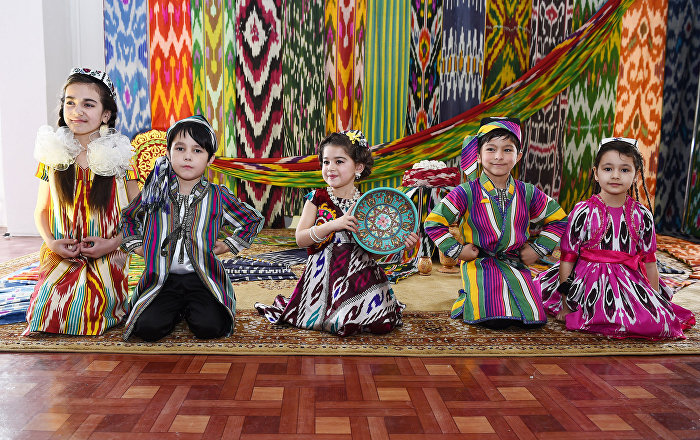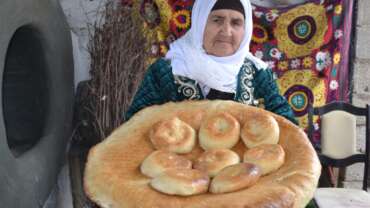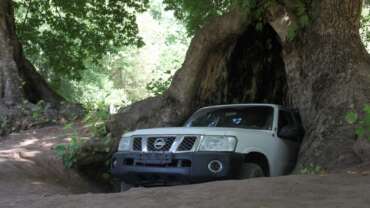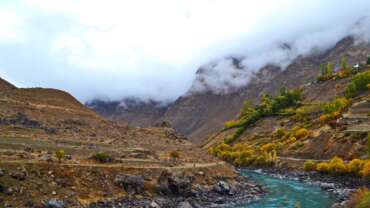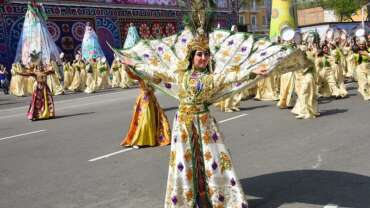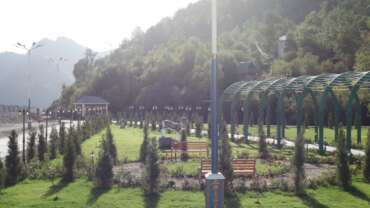Experiences in Tajikistan
The ancient land of Tajikistan is famous for its architectural monuments, natural beauty and unique sights. There are many picturesque crystal clear mountain lakes in Tajikistan, towering snow-capped peaks, thousand year-old fortresses, mausoleums and mosques. Tajikistan combines the magic of ancient history with the intense beauty of some of the world’s tallest mountain ranges.
The main architectural sights of Tajikistan are concentrated in the west of the country: the monuments of Khujand, Istaravshan, Penjikent and Dushanbe. Most of them are connected to important trade routes that passed along the main rivers of Central Asia, the Syrdarya and Amudarya. Indeed, the Great Silk Road played an important role here.
In Khujand, you can see the ancient Khujand fortress that since been turned into a history museum; you can also visit the Panchshanbe Bazaar and the Mausoleum of Sheikh Muslikhiddin, located nearby. Istaravshan has one of the oldest sights of Tajikistan, the Khazrati Shoh Mausoleum. Excavations of the ancient settlement of Sarazm and other monuments can be found in Panjakent.
It is hard to picture Tajikistan without the Hissar Historical-Cultural Complex, located 20km away from Dushanbe. The famous Hissar fortress is there, alongside the Kuhna Madrasah and many other medieval monuments.
Most of the modern sights of Tajikistan are gathered in the capital city, Dushanbe. The main landmark is Dusti Square, with a monument to Ismail Somoni, the Stele of Independence, and several other monuments. It is also worth mentioning the Museum of Antiquities, with a collection of thousands of exibits that tell the history of Tajikistan; a sculpture of Buddha in Nirvana, a replica of an ancient statue found in southern Tajikistan, stretches across 13 meters (42 feet).
The mountains and lakes are the best natural sights of Tajikistan. 93% of the territory of the country is located in the mountains, meaning that there is no shortage of territory to explore. The highest peaks reach over 7000 meters (22,965 feet) and the total number of lakes exceeds 2000. There are also amazing valleys, waterfalls, mineral springs, glaciers and other sights hidden among the peaks.
Lake Iskanderkul is one of the most striking sites in Tajikistan. This gem is hidden in the depths of the Fann Mountains in western Tajikistan, though it is not difficult to get there – only 3-4 hours by car from Dushanbe. Iskanderkul is surrounded by cliffs and mountains, making it a unique place to visit.
The most famous and most stunning places in Tajikistan are in the Pamir Mountains. The Pamirs are one of the highest mountain ranges of the world. In the Pamirs, one can find rough landscapes, wild rivers, huge glaciers and snow-capped mountain peaks. In addition, there is a semi-extreme road, the Pamir Highway, perfect for thrill-seekers.
Tajikistan nature can also boast a number of mineral springs such as Garm-Chashma, the high-mountain Karakul Lake, and the Seven Lakes, that descend cascaded down a gorge not far from Panjakent.
Any traveler can find something for their ideal vacation in Tajikistan. From ancient cultural monuments in Khujand and Panjakent, to the towering peaks and clear lakes of the Pamirs, Tajikistan is sure to leave life-long memories with any visitor.
Excursion Around Dushanbe
Dushanbe is cozily placed between among the mountains. The first mountains are within a hundred-meter reach from the city boundary. The main street of Dushanbe is Prospekt Rudaki. Going along it you can view numerous places of interest.
Squares of Dushanbe
Sadriddin Aini Square. There stands the writer’s monument opened in 1978 when entire country was celebrating his100th jubilee. The statute of Sadriddin Aini is surrounded with all characters of his books.
Moscow’s 8th Centennial Square. One of the most beautiful places of the city, surrounded by Indian lilacs. In the center of the square there is a big fountain; it is favored by students, artists, musicians, and actors.
Dousti (Friendship) Square. The largest and the most elegant square in Dushanbe. In the center stands Ismail Samani monument; nearby is the museum constructed in the honor of the 1,100th anniversary of Samanid state. There is also the House Tajikistan Government.
Putovsky Square. It is decorated with beautiful fountains, colorful flowers and magnificent spruces. The Presidential Palace is located right there.
Cultural Institutions
Firdausi Republican Library. The library building was constructed in traditional Tajik style in a combination with the elements of modern architecture. It stores two million books in many languages of the world. The most treasured there are books written by the peoples of Ancient Orient, two thousand manuscripts of Rudaki, Firdausi, Ibn Sino, Saadi.
In the center of the capital on the right side of Prospekt Rudaki is located Russian State Drama Theatre named after V. Mayakovsky. This is the center of Russian culture in Tajikistan. There is also Tajik State Academic Drama Theatre named after A.Lakhuti.
Aini Square hosts Bekhzada Republican History, Local Lore and Fine Arts Museum.
The Botanical Garden of Tajikistan Academy of Sciences contains the collection of unique trees and plants from all over the world.
Museum of Ethnography contains the samples of Tajik arts with the display of pottery, carpets, jewelry and musical instruments from all historical epochs of Tajikistan.
Opera and Ballet Theatre named after Aini is located on Moscow’s 8th Centennial Square. very impressive is the facade of the building which is push forward towards the square is supported by classical columns. The ornaments of the building contain Tajik motives.
Hissar, Tajikistan
Located 30 km from Dushanbe (4-5 km from Hissar settlement) is one of the most important landmarks of Tajikistan – Hissar History and Culture Reserve. This name is related to archeological and architectural monuments of different ages found on its 86-hectar territory. The reserve location – Hissar Valley – is a vast intermountain hollow with the rivers Kafirnigan, Karatag and Shirkent. People inhabited this place in the Stone Age, in the 4th-3rd millennia B.C. Later the valley territory was a part of Bactria, and then of Greek-Bactrian and Kushan states. This fact is proved by the remains of ancient settlement found by the archeologists. However, today only orbicular mounds called “tepa” – “a hill” – has survived. In the Middle Ages Hissar was known for its crafts and markets. In the 18th – 19th centuries it was known as Hissar province – one of 28 domains of Bukhara Emirate. Hissar fortress which has survived since those times is considered the most famous landmark of the reserve.
The city is located in the central western part of the republic, in the center of Hissar Valley, the greenest and the most densely populated part of the country. The city is surrounded by mountains: from the north by
The Hissar Ridge, from the south – the Gazimalik Mountains, from the southwest – the Babatag Mountains. It has been proven that people inhabited Hissar Valley 40 thousand years ago.
The sacred book of Zoroastrians «Avesta» mentioned this area as «Shumon». For the first time the word «Hissar» («hissor») as a name of a settlement, city or an administrative unit was mentioned in the 11th century. Then this word designated a site of ancient settlement with state armies, crafts, and a market. Way back then the city was the center of the most independent part of Samanid state.
In the late 19th and the early 20th centuries the architectural complex of the city consisted of two madrasahs, over a dozen mosques, four city gates, and a central market. The construction the modern Hissar in the form of kishlak began in the beginning of the twentieth century.
Hissar Landmarks:
Hissar is known for its unique historical and cultural reserve organized in the late 1980s. It comprises:
1. Hissar Fortress with the arch (gate). It was erected manually. It is 2,500 years old. The main gate is the arch one. The gate was constructed in the 16th century and now they have been completely restored.
2. Registan (the square in front of the fortress).
3. Old madrasah. This medieval educational institution was built in the 16th century. The madrash’s area is 2,250 m..
4. New madrasah.
5. Caravanserai (hotel). The brick caravanserai was constructed in 1808 during the rule of Saidbi Atolik and was used as a hotel.
6. Chashmai Mokhiyon mosque (the Stone Mosque). It was built in the 8th century. The two verandahs and the tower – in the 15th century .Today it has been restored to its original appearance.
7. Sangin mosque.
8. The mausoleum of Makhdumi Azam is a historical monument of the 16th century; it was erected on the place of Khodzhi Muhammed Khaivoki’s tomb. The area of the mausoleum is 609 sq. m.
9. The History Museum. It is located in the building of old madrasah. The entire nomenclature of monuments and exhibits (more than 3,200 items), found during excavation works on the territory of the city of Hissar and beyond is kept there.
Sights of Khujand
Any traveler, who is touring by the track of the Great Silk Road, must visit Khujand and its suburbs. This city is as old as Bukhara and Samarkand, and it witnessed Alexander the Great, who fortified it and called Alexandria Eskhata. It preserved medieval monuments, mosques, mausoleums, and the remains of the fortress, which is as old as the city itself. The city’s history is excellently displayed in the Museum of local lore adjacent to one of the walls of the Khujand fortress.
Khujand is interesting for lovers of ethnic tourism, located on the road between Samarkand and Kokand it incorporated many of the features of the peoples inhabiting these areas. It is home to the Tajiks, Uzbeks and representatives of other nationalities. Furthermore, it is called the Northern capital of Tajikistan and is the second largest city in the country.
Many people will also be interested in Khujand nature: near it, there is the Kayrakkum reservoir and mountains, whose slopes are covered with huge orchards. The lovers of mountain climbing will be interested in Aksu district, located two hours to the south, where the sky is cut through by the rocky peaks, rising over 5,000 meters.
The main attractions of Khujand
Mausoleum of Sheikh Muslihiddin
This memorial complex consists of mosques, khanaka minaret and different depositions, including the Mausoleum of Sheikh Muslihiddin, the famous poet and ruler of Khujand of the XII century.
Khujand fortress
Practically from the very beginning, Khujand, it was protected by high walls. The city’s heart was the fortress. Over its 2500-year history, the Khujand fortress was destroyed by the invaders, built anew, expanded, but still continues to be a symbol of the courage of the people.
Kairakkum
A 20-minute drive from Khujand, after a small slope, greets the Kayrakkum reservoir. It is a popular place for recreation, also known as the Tajik Sea.



